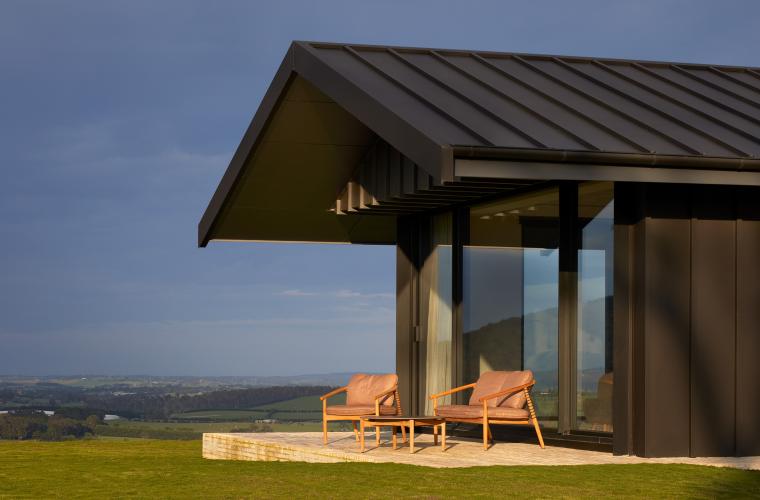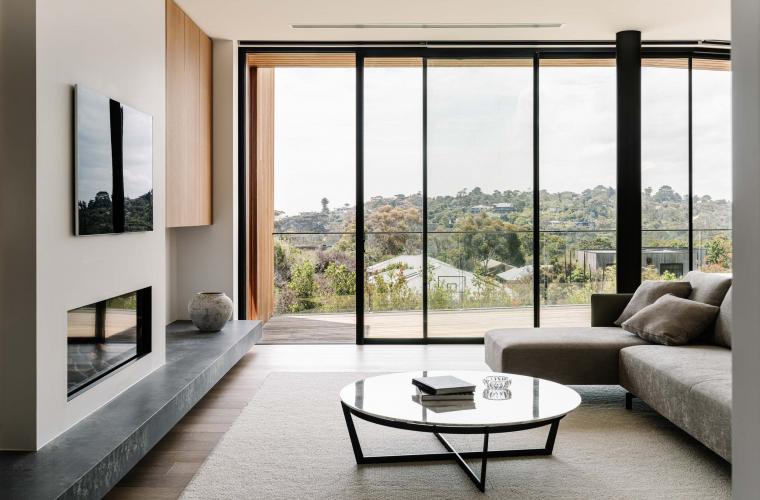Origami Pool House
03rd May 2019
Words from Viridian:
https://www.viridianglass.com/inspiration/case-studies/24_origamihouse_hawthorn
Mediterranean sea-caves, Japanese origami and a North American mid-century glasshouse are all clues to this jewel-like swimming pavilion. Tucked away in suburban Melbourne, its lightweight aesthetic and folded planes defy the stampede towards construction of epic scale.
_
MADE GROUP'S poolhouse is a virtual tip-toe across the lily-pads such is its finesse and the way it transcends mere utility for super poise and elegance. Located in suburban Hawthorn where houses of mausoleum proportions are becoming the norm, the poolhouse strips down to its six-pack and the bare essentials.
Enclosing an existing pool, its X-ray structure ensures year-round family use instead of the seasonal plunge. Rather than endlessly heading to the local pool, the owners save themselves the drive and now swim, bathe and enjoy pavilion life throughout all seasons.
Convenience to one side, the design follows in the great tradition of the pavilion as free-standing object of pleasure. MADE's design straddles the water with a pitched, vented roof and sliding, operable walls along three elevations for sublime counterpoint.
Such glazing offers brilliant sun-drenched transparency when closed—or in maximum aperture mode, as giant, cooling breezeway. Either way, it’s a full sensory experience to harness, rather than deny the elements.
_
Vision’s Peter Hyatt spoke with MADE architects Colin Beanland and Michael Huynh about ideas, technology and a pavilion as truly immersive environment.

This is such a lightweight building. How did it come to pass?
Colin Beanland: We wanted to maintain as much of the garden as possible. The idea was to create a folded form that provided shelter and opened up completely during summer and closed in winter. We recognised the importance of visual permeability which explains why there is so much glass.
It’s such a simple, un-fussed material palette which contrasts so much of the neighbourhood.
Michael Huynh: The inspiration was to connect with nature so the materials we chose were raw and textural. In terms of the form and shape we did some studies on cross-ventilation and lighting during summer and winter and so it was really about working with the elements at all times of the year.
And of course there’s the whole Japanese element of origami you acknowledge very openly.
MH We took the idea of origami as very light and floating. This pool is very much like a pond, and so from that we took the idea of folding planes to create a really light, permeable structure. The second idea was the sea cave with varying spatial volumes. At one end there is a more intimate space with the low ceiling. On the other end it opens up completely and daylight pours in. It was taken from the idea when I was kayaking on the coast at Lagos in Portugal. You go through these sea caves with really low ceilings and all of a sudden a hole opens up to the sky. It was a beautiful experience.
This is technically and creatively a really elegant solution. Tell me about your rationale for glass?
CB Glass was quite fundamental to our concept because the whole idea is for physical and visual permeability. Glass played an integral part in the visual permeability, especially in winter, because the idea was that it was firstly a light, flowing form. We wanted a very subtle, elegant result inspired in part by Philip Johnson’s glass house. It’s just the really light, slim-lined form with glazed walls and glazed ceiling. We looked into a few systems for the ceiling that provided insulated properties so that’s why we went with Viridian ThermoTech™. We engaged a mechanical engineer to set some parameters for that highly controlled environment—especially in winter mode. The external ThermoTech™ skin together with the Bauer system achieve those high values.
The ThermoTech™ used in the ceiling is around 40 mm thick. Why such a size?
CB Apart from ensuring the optimum heat retention performance, it’s also a very clear product, used throughout for optimum transparency. That thickness also permits easy roof access for any maintenance and cleaning.
What has been your experience with Viridian?
CB Mainly working on residential projects we will regularly call-on their resources to research and supply the optimum product for the purpose. We called them on this project and they were fantastic.

Was this for technical information or product samples?
CB Their engineer performed the calculations needed and that information, along with samples, became part of the building process, so Viridian’s input was quite invaluable.
Anything else that informed or inspired you?
CB We wanted a quite sculptural result much less like a building and more like a piece of art in the garden.
Modern building often sees clients wooed by mass and weight, whereas you pare it right back to the essentials as expressed and exposed performance.
MH Part of the brief was to respect the existing building and we wanted to complement, rather than mimic or take inspiration from it. We responded to its considerable mass and large, boxy forms because it didn’t need a repetition of that in the garden.
Why not just rely on solar heating?
MH This isn’t saying: “Let it just sit there and pump solar heated water all day long.” Having that enclosure allows us to manage that. That seems to me to be a pretty smart idea, that it doesn’t have to be inside or outside. In fact, you’ve got the best of both worlds. That’s essentially the spirit of this as well.
CB There was an existing pool we had to protect. Our clients were sitting here in the middle of winter and the pool is virtually shut down. There was frustration on their part being restricted to so few months of the year.
You use an integrated temperature management system in addition to the sliding walls as doors.
CB Yes, it’s known as a Bauer system from Germany and very, very gently introduces air at two atmospheric pressures without gusting like conventional air-conditioning. Those two atmospheric pressures create a blanket over the water to keep any moisture or condensation from rising, so it’s a different concept to most other pools that you see in Melbourne.
Does it offer any other role than as pool house?
CB If the owners have a party they can easily open up the end wedge for seating and so it interacts with this space and it’s no longer just a pool. It becomes a much bigger entertainment space.
What are the lessons beyond this kind of project for commercial and residential that you could transfer elsewhere?
CB We weren’t exploring this in preparation for other projects, but perhaps over time when we pull back and realize what we did learn here, we will make use of that.
MH What worked exceptionally well was the concept of architect-led design and construct. We carried through the concept and didn’t spend a lot of time negotiating with the builder to beat a price. We had the idea and the clients ran with it, and we had their trust. That allowed us to spend all our energy and focus on delivering the project within budget and in line with the design concept.
Did being the designer and builder bring benefits?
CB As an architect-led design and construct you’re in a better position to make value management decisions. It’s just how to really get the most bang for your client’s buck. If it’s led by a builder or someone else who isn’t intimate with the design, you risk losing the design over the process. We worked on this as one entity rather than hoping nothing was lost in translation between the designer and builder.

Project: Origami Poolhouse, Hawthorn, Melbourne
Architect: MADE Architecture
Design Team: Colin Beanland & Michael Huynh
Engineer: Macleod Consulting
Builder: MADE Construction Group
Window Supplier: Thermeco
Window Fabricator: European Window Co.
Glass supplier: Viridian
Principal Glazing: Viridian ThermoTech™
Size: 115m2









